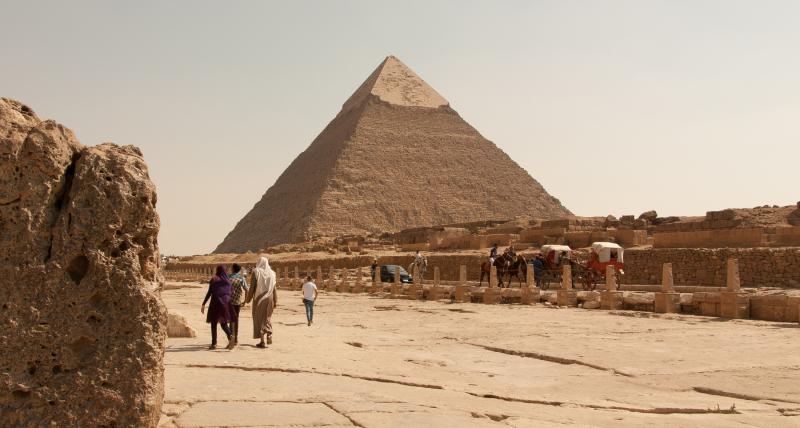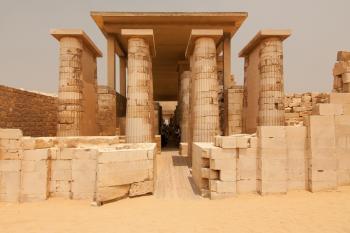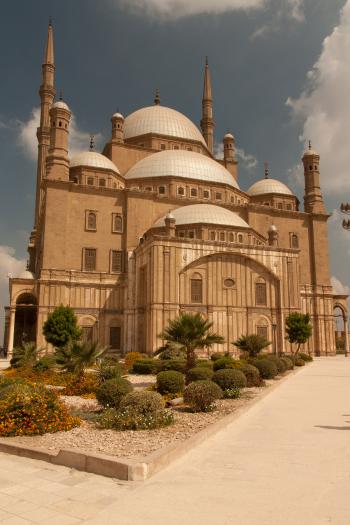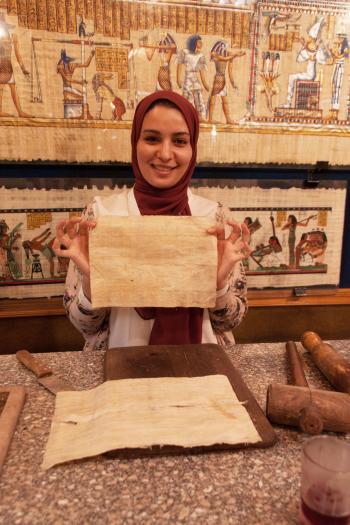Awestruck by the accomplishments of an ancient civilization on a private tour of Egypt
This article appears on page 6 of the November 2018 issue.
There are few things that make me emotional. I didn't expect one of them to be Egypt.
For me, Egypt was one of those legendary places filled with ancient biblical history and incredible monuments that have literally stood the test of time. When Amazing Global Travel presented an opportunity to visit, there was no hesitation in my response.
Jumping right in
I arrived at one of the most populated cities in the world at 1:30 a.m. on July 11, 2018, and, thankfully, a rep was waiting to greet me with my visa, ushering me through Immigration and Customs and to my overnight airport hotel, Le Passage Cairo Hotel & Casino, a 5-minute drive away.
The first sign that I wasn't in Kansas anymore was the armed guard at the hotel's front gate who, with his dog, inspected the exterior of our vehicle before allowing us to enter the property. When we reached the entrance, my bags were x-rayed and I had to pass through a metal detector before entering the hotel. This was to be the norm for every hotel and historical location I would visit.
After a few hours' sleep, a buffet breakfast and a quick hotel checkout, I was met by my guide, Egyptologist Gemy Omar, and driver, Jamal, who were ready to whisk me off for a close-up look at ancient Egypt.
But first, we encountered Cairo traffic. I was amazed and scared at the same time! Coordinated chaos is the only way I can describe it.
Tuk-tuks and donkey carts and 3-wheeled motorcycle carts all are part of the vehicle menagerie with which Cairo drivers must contend.
Saqqara
My first stop was Saqqara, where, of the more than 100 pyramids in Egypt, the oldest is located. Built (beginning in 2630 BC) for the third dynasty's Pharaoh Djoser, this step pyramid is more famous for its architect, Imhotep, than the pharaoh for whom it was built.
Prior to this construction, mastabas (graves) were customarily rectangular monuments of dried-clay bricks built above the underground passages in which the dead were buried. Imhotep envisioned something on a much grander scale for his king and stacked progressively smaller masatabas, built from stone, atop one another, forming what is known as the step pyramid.
This 204-foot-tall pyramid is not the only attraction at Saqqara, however. The Imhotep Museum, opened in 2006, sits just inside the site's entrance and features ancient artifacts recovered from surrounding tombs, including tools, statues, alabaster jars and even a mummy.
From the museum, it was a short drive up to the pyramid complex, the first place on this trip where I would be overcome with emotion. I was walking on ancient ground, standing in front of 4,000-year-old limestone walls and walking in the footsteps of a pharaoh. I was able to reach out and touch carved columns of antiquity and I was speechless, awestruck by the mere grandeur of the place.
It all was a bit overwhelming, a feeling that would remain with me throughout my time in Egypt.
Though entry to Djoser's pyramid is restricted, other tombs are accessible. I was able to descend into the smaller pyramid of King Unas to view the hieroglyphics carved into walls of alabaster and limestone and peer into the empty sarcophagus where the pharaoh's coffin once lay.
I also entered the royal tomb of Princess Idut, where remarkable depictions of everyday life in Egypt are carved into the limestone; in some places, the colors remain. Gemy filled my head with facts and figures as he described the carvings in detail, offering a glimpse into what life was like in ancient Egypt.
Leaving the pyramid complex, we made a brief stop at a carpet-making school, where young kids are each given the opportunity to learn a trade in addition to obtaining an education, allowing them to make a living outside their traditional farming community.
I watched as students skillfully tied knots on giant looms, following an intricate pattern at such speed that they made it look effortless. My young tutor demonstrated a few knots and then let me tie a few. I was obviously no master, but it was fun to try!
Giza
After a lunch of falafel, stuffed cabbage, baba ganoush, tahini, lamb kofta and chicken kebab, plus refreshing lemonade with mint, we made our way to the Giza pyramid complex and the Great Sphinx.
Once situated in the desolate desert above the reach of Nile floodwaters, these grand monuments are now surrounded on three sides by civilization. Even the new Grand Egyptian Museum (GEM), scheduled to open in early 2019, is located a stone's throw away.
While there, I couldn't pass up the opportunity to ride a camel ($20), and after getting directions on how to mount and hold on while the camel stood up, I enjoyed the 15-minute ride for a south-facing view of these great pyramids.
There was just enough time left in the day to see the iconic Great Sphinx before the gates closed. Carved out of a single stone, this 66-foot-tall, 240-foot-long behemoth sits as a solitary guard to the pyramids at Giza.
With the body of a lion and the head of an Egyptian pharaoh (thought to be Khafre), this old cat is beginning to show its 4,500 years of age. At the time of my visit, it was undergoing restoration, but it was no less impressive.
The last stop of the day was the Egyptian Perfume Palace (9 Sphinx St., Nazlet El Samman, Giza), where I was offered a refreshing hibiscus tea and was enchanted by the delicate fragrances of a variety of essential oils.
With my first day's touring complete, Gemy helped me check in at the Marriott Mena House, my home for the next two nights. Located in the shadow of Giza's great pyramids, this historic property was a tranquil oasis from the chaotic traffic outside its boundaries.
Cairo
After my buffet breakfast, Gemy picked me up and we drove back along the Ring Road to Cairo, this time to the Citadel of Saladin, which offered views of the entire city.
Originally built between 1176 and 1183, the citadel evolved throughout the centuries, with walls, wells and aqueducts — and the beautiful, Ottoman-influenced Mosque of Muhammad Ali Pasha, more commonly referred to as the Alabaster Mosque — being added.
I was awed by the mosque's beautiful architecture and carved alabaster columns on the outside, and, once inside the courtyard, I found the mass of marble and ornate carvings astounding. Inside, the massive carpeted sanctuary was illuminated by a single enormous chandelier.
This was the only site where, out of respect, I needed to have my shoulders covered, and I also wore a long skirt.
We then made our way to Cairo's Egyptian Museum, where, honestly, I think I could have spent the rest of the day. Alas, I had only two hours allotted, but Gemy did his best to cover all the highlights.
Of course, no visit to the Egyptian Museum would be complete without viewing the vast treasures of Tutan khamun, and what a delight they were to see. From the canopic chest that held Tut's embalmed organs to the delicate and detailed innermost coffin of gold adorned with semiprecious stones, I couldn't help but be moved by the dedication and talent of the ancient artisans who worked tirelessly for their king.
Note: If you want to take photos inside the museum, an extra ticket is required (EGP50, about $3). However, no photos are allowed inside the special Tutankhamun exhibit.
We had a delightful lunch of koshary (koshari), the national dish of Egypt — a perfect blend of rice, pasta, seasoned tomato sauce, chickpeas, lentils and fried onions doused in garlic vinegar (and hot sauce, if you desire). The rest of our afternoon was filled with visits to Cairo's ancient churches.
Jamal dropped Gemy and me off at the entrance to a pedestrian-only street, and we walked the few blocks to a stairway that led us below street level to a narrow alleyway lined with vendors. Our destination was the Cavern Church (aka Saints Sergius & Bacchus Church), which reportedly was one of the places where Joseph, Mary and the baby Jesus hid when they fled Bethlehem and Herod's murderous rampage. There's even a marker at the well from which some believe the Holy Family drank.
Leaving the Cavern Church, we continued along the alleyway to the Ben-Ezra Synagogue (formerly a Coptic church), said to be the spot where the baby Moses was discovered. Then we retraced our steps back to the main pedestrian street and ventured over to The Hanging Church, so called because it was built over the gate of a Roman fortress.
This Coptic church dates back to the 8th century and is considered one of the most important sites in Coptic Christianity.
On to Aswan
My journey to Aswan for the second half of my tour began at 2:30 a.m. with a transfer back to the Cairo Airport for a 5 a.m. Egyptair flight. I was surprised at the number of people out and about at that hour — obviously taking advantage of cooler temperatures — and at the many stores that were open for business and the food-delivery motorcycles that were darting about.
Even as we crossed over the Nile, street vendors catered to those gathered on the bridge overlooking the lighted party boats below. Not even the donkeys slept, as I saw at least one cart out. Cairo is certainly a city that doesn't sleep!
Arriving in Aswan an hour later, I was met at the airport by another driver and guide, and together we traveled 30 minutes across the desert landscape to the city and my next Egyptian adventure: a 3-night Nile River cruise to Luxor aboard the Sonesta St. George 1.
Debi's journey continues next month as she sets sail on the Nile. Debi was the guest of Amazing Global Travel (Chandler, AZ; 480/840-1947, www.amazingglobaltravel.com).





